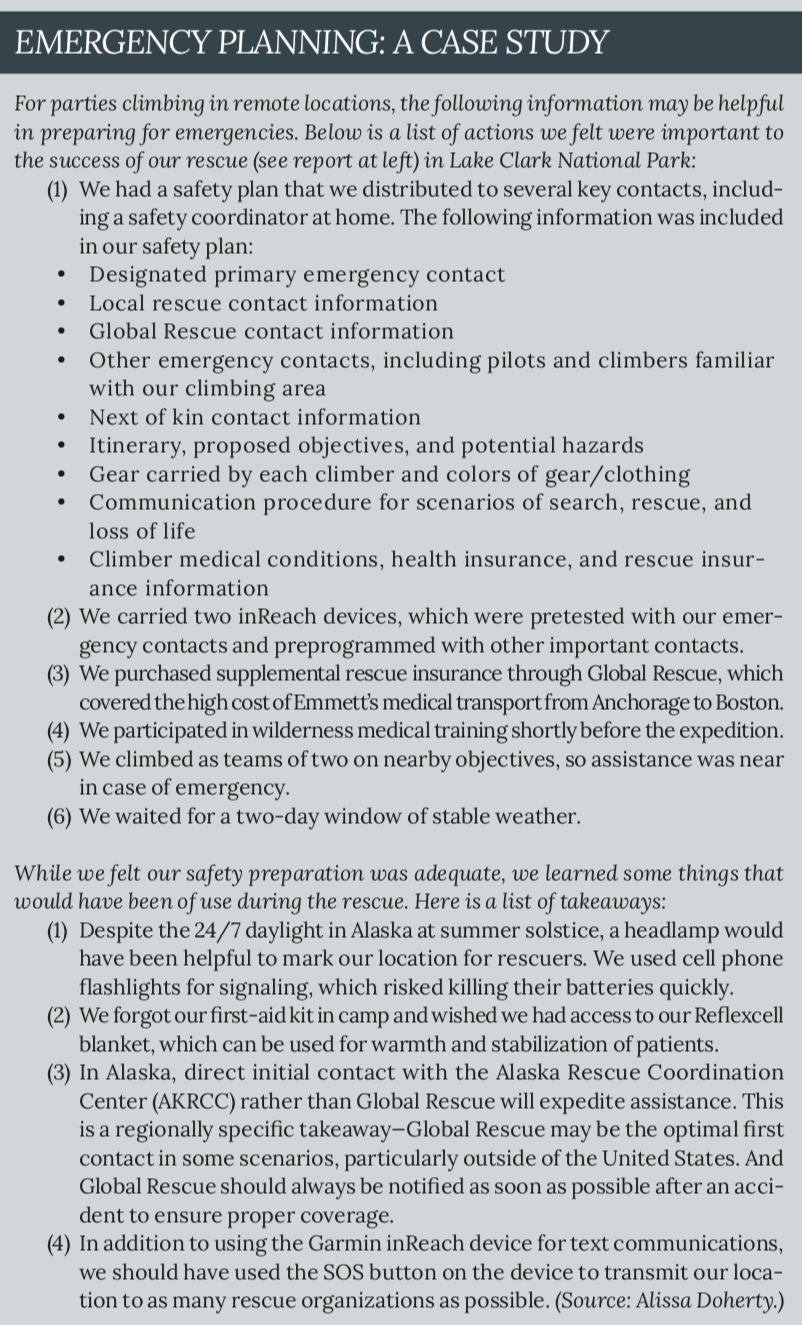Fall on Rock – Loose Rock
Alaska, Lake Clark National Park, Hidden Mountains

FOUR CLIMBERS set out to explore the little-known Hidden Mountains in Lake Clark National Park in June. Their goal was to make first ascents of peaks in this remote region by climbing rock routes in single-push style. The day of the accident, the climbers had split into two parties, opting to climb neighboring ridgelines on the same peak. With a two-day window of stable weather, they each planned to ascend approximately 1,500 feet of class 4 and 5 terrain to the summit. Both parties carried Garmin inReach devices, making satellite texts possible.
On the evening of June 23, Emmett Lyman, 40, was 150 feet from his belayer, leading a pitch of approximately 5.7, around 800 feet above the start of the route. At 8 p.m., his belayer heard sizable rockfall and an inaudible reaction from Emmett. The belayer felt the rope tighten, presumably arresting Emmett’s fall. She could not see Emmett but tried to initiate verbal communication and received no response.
After approximately 10 minutes, Emmett's partner contacted the other members of the party, Alissa Doherty and John Gassel, via inReach. Alissa and John were 300 to 400 feet above and to the left of the injured party and immediately began a traverse and descent in an attempt to reach him. Meanwhile, Emmett's belayer initiated the team’s emergency response plan by contacting Global Rescue and the expedition’s emergency contact. She tied off the brake strand of the belay rope to free her hands but did not move or attempt to transfer the loaded rope to the anchor, out of concern that moving Emmett might cause additional rockfall or injury.
While making their descent, Alissa and John established visual and verbal communication with Emmett, who was unconscious but responsive to verbal stimulation. Realizing they would be unable to reach him directly, they descended to the anchor where Emmett's partner was belaying, reaching this point at approximately 1:45 a.m.
At this time, the climbers heard an HH-60 Pave Hawk helicopter responding to their distress call, piloted by rescuers from Elmendorf Air Force Base’s 210th Rescue Squadron. A thick fog obscured the peak, and the climbers were unable to establish visual contact with the helicopter. After an initial search, the helicopter dropped off three pararescue specialists at the climbers’ base camp and departed to refuel.
During this time, Alissa belayed John up the rock to reach Emmett. John built an anchor above the gear that had arrested Emmett’s fall and rappelled to him. He confirmed their assumption of head and neck trauma, covered Emmett with warm layers, and continued communicating with him while waiting for the helicopter to return.
At the anchor below, the other two climbers established visual and verbal communication with the pararescue team in base camp, and they relayed the climbers’ location to the pilots. After two stalled attempts to navigate in thick fog, the helicopter retrieved the pararescue team and started upward toward the injured climber.
Once in position, a pararescueman descended via hoist line, and John helped the rescuer reach the cliff. The line was attached to the injured climber’s harness. Due to the helicopter’s proximity to the cliff and Emmett’s suspended position, spine stabilization was not possible. Emmett was hoisted into the helicopter at approximately 5 a.m., and rescuers began immediate medical treatment. He was flown to a hospital in Anchorage and was in surgery by 6 a.m.
The injured climber survived the accident and evacuation, having sustained two fractured vertebrae, spinal cord injury, closed head injury with associated traumatic brain injury, and an open fracture of his right arm. The remaining three climbers descended via rappel and returned to base camp at approximately 10 a.m. on June 24. They flew out the next day.

ANALYSIS
The injured climber had placed adequate gear (approximately 10 pieces in 150 feet), and his fall was arrested by the last piece he placed (a medium-sized nut). The fall distance was 20 to 30 feet. He was climbing within his technical ability and was wearing a helmet, which was lost when he received trauma to the head.
We believe that loose rock was responsible for the accident. Emmett likely weighted a loose or broken block, which in turn dislodged other rocks while also causing him to fall. A similar accident might be avoided by selecting objectives with high-quality rock or by retreating when loose rock is encountered.
This rescue was extremely well coordinated and executed. We were extraordinarily fortunate to receive specialized helicopter assistance within 10 hours of the accident. This expediency was unusual, given our remote location, and should not be counted on in any circumstances. In our case, light winds and a brief clearing of the fog on the mountain, along with efficient decision-making within the Alaska Rescue Coordination Center (AKRCC), were critical to the speed of the operation.
We owe deep gratitude to the AKRCC and the pilots and pararescue specialists from the 210th, 211th, and 212th squadrons at Elmendorf Air Force Base. Staff Sergeant Adam Brister was nominated for the Airman’s Medal in recognition of his heroismduring the rescue. (Source: Alissa Doherty.)


